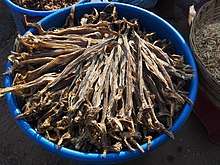Bombay duck
Harpadon nehereus, called the Bombay duck, bummalo, bombil, and boomla is a species of lizardfish. Adults may reach a maximum length of 40 cm, but the usual size is around 25 cm.[1]
| Bombay duck | |
|---|---|
.jpg) | |
| Scientific classification | |
| Kingdom: | |
| Phylum: | |
| Class: | |
| Order: | |
| Family: | |
| Genus: | |
| Species: | H. nehereus |
| Binomial name | |
| Harpadon nehereus (F. Hamilton, 1822) | |
Etymology

The origin of the term "Bombay duck" is uncertain. One popular etymology claims that the overpowering smell of the dried fish when transported by mail train (the Bombay Daak) led to the phrase "you smell like the Bombay Daak" in the days of the British Raj. However, the Oxford English Dictionary dates "Bombay duck" to at least 1850, two years before the first railroad in Bombay was constructed, making this explanation unlikely.[2][3]
According to local Bangladeshi stories, the term Bombay duck was first coined by Robert Clive, after he tasted a piece during his conquest of Bengal. He is said to have associated the pungent smell with that of the newspapers and mail which would come into the cantonments from Bombay. The term was later popularized among the British public by its appearance in Indian restaurants in the UK.
In his 1829 book of poems and "Indian reminiscences", Sir Toby Rendrag (pseudonym) notes the "use of a fish nick-named 'Bombay Duck'"[4] and the phrase is used in texts as early as 1815.[5]
Distribution and fisheries
The Bombay duck lives in the tropical areas of the Indo-Pacific. The fish is also known as "strange fish"5th because of its discontinuous distribution along the Indian coast. It has been traditionally caught in the waters off Maharashtra in the Lakshadweep Sea, where it is an important item of the yearly catch. This fish is also caught in the Bay of Bengal and in the South China Sea, although in smaller numbers.[6]
The fish is often dried and salted before it is consumed, as its meat does not have a distinctive taste of its own. After drying, the odour of the fish is extremely powerful, and it is usually transported in air-tight containers. The Bombay duck is a popular food item in certain areas of India. Fresh fish are usually fried or cooked in curry.
International availability
.jpg)

At one time, 13 tonnes of Bombay duck were eaten in the UK each year. Following the discovery of a batch of imported seafood contaminated by Salmonella in 1996, the European Commission (EC) prohibited fish imports from India other than from approved freezing and canning factories. As Bombay duck is not produced in a factory, this had the unintended consequence of banning the import of Bombay duck. After a campaign to "Save Bombay Duck", the Indian High Commission approached the EC about the ban, and the EC adjusted its regulations so that the fish can still be dried in the open air, but has to be packed in an "EC approved" packing station. A Birmingham wholesale merchant located a packing source in Mumbai, and the product became available again.[7][8] Bombay duck is available fresh in Canada in cities with large Indian populations, such as Toronto and Montreal, and is generally known as bumla. Although mainly popular with Indians from Bengal, southern Gujarat, coastal Maharashtra, Goa, and Karnataka, it is increasingly consumed by the other South Asian populations, Bangladeshis in particular.
References
- FishBase - Harpadon nehereus
- duck, n.1. Oxford English Dictionary, 2nd ed., 1989; online version December 2011. Accessed 2 February 2012.
- IR History: Early Days - I. Indian Railways Fan Club website. Accessed 2 February 2012.
- Toby Rendrag (sir, pseud.), Poems, original, lyrical, and satirical, containing Indian reminiscences of the late sir Toby Rendrag, Publ. 1829 W. Boyls page 26
- A. Clark, William Combe, Paddy Hew: a poem : from the brain of Timothy Tarpaulin, Printed for Whittingham and Arliss, 1815, 195 pages, page 86
- "Harpadon nehereus". Integrated Taxonomic Information System. Retrieved 18 April 2006.
- "Save Bombay Duck". Bombay-duck.co.uk. 16 December 2003. Retrieved 25 July 2009.
- "Bombay Duck bounces back". news.bbc.co.uk. BBC. 12 December 2000. Retrieved 12 October 2017.
External links
